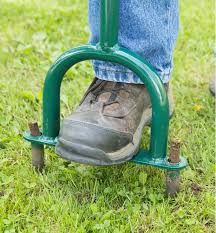
Love them or hate them, the lawn is a part of our communities. For those that love them, they are a little park of our very own. A place to gather with others. A place for the kids to play. For those that hate them, they are a constant source of work and frustration.
For years people have been fed the story that we need to aerate and power rake in the spring and spray weed killer & lawn feed, or some other chemical, on our grass. Then we cut the grass as short as possible to give it the “manicured look” all summer, and water it everyday with municipally treated water. In the spring, the dandelions come up first before the grass is green. We do it all over again.
THERE IS ANOTHER WAY!!!!!

Height:
There are many varieties of grasses and they all have different characteristics. The grass on your lawn can not be just cut shorter to create a golf course green. (Something I have been asked by a couple of people about over the years.) Golf courses use specific species of grasses and a strict mowing schedule to create what they do.
The ideal height for the standard residential lawn is 2 ½ – 3”. Only annual bluegrass (which is considered a weed in most places) and bent-grass (which is what they use on golf course greens) can tolerate being mowed lower than 1″
We should not cut more than 1/3 of the shoot height either. So if your lawn is 3” high, you can cut off 1” to a height of 2”. If your lawn is 4 ½” high you can cut off 1 ½” to a height of 3”.
Don’t cut it down below 2”!

Mowing at the optimal height leaves the plants with sufficient photosynthetic capacity to maintain a strong root system, and still leaves the lawn thick and strong enough to support foot traffic without flopping over. The longer leaves or tillers cushion the crowns, and create a dense canopy that prevents water evaporation from the soil surface. It also provides a lot of surface area to catch the morning dew – which is an important source of water in the summer.
Lawn Mowing Frequency:
In late spring and early summer, when the grass is growing quickly, mowing every 3rd or 4th day may be advisable. When the grass is dormant during mid summer, we don’t have to mow at all. The mowing schedule should be determined by how fast the grass grows, not by the calendar or pocketbook.
How The Lawn Grows:

Without getting too deep into Rhizomes and Stolons and the intercalary meristem, there is a few things to keep in mind for the average lawn.
Grass has a crown.
Cut above the crown, plant survives. Cut below and the plant dies. The lower the crown to the soil surface, the shorter you can cut the lawn. Crowns are also the grass plants major storage organ. The healthier the crown, the more tillers / leaves it will have. The more tillers, the denser the turf. This is not only more beautiful, it also protects the crown better from injury, reduces the evaporation of water from the soil, and shades out germinating weed seeds

Water:
By late spring, leaf production outpaces root growth, which peaks in early summer. As the temperature rises, leaf production drops. The grasses in the lawn will remain green, as long as they have sufficient water. As the weather gets cooler again, leaf production increases until it peaks again in early fall. Then it quickly drops once more, until the grass goes dormant for the winter.
If the summer heat is coupled with drought, some cool season grasses can enter into complete dormancy. In this case, the plants withdraw their energy into their crowns. They allow the foliage, and many of the roots, to die. The size and vitality of the crowns will determine the length of drought an individual plant can withstand. During an extended drought a good proportion of the weaker plants die, resulting in a thinner turf than before the drought.
The absolutely worst thing we can do is to force the plants in the lawn to do something they are not naturally supposed too. Cutting the lawn very short, and fertilizing with synthetic nitrogen fertilizers direct too much energy to the leaves in the early spring. These activities stimulate immediate shoot growth to replace the photosynthetic capacity at the expense of root growth, which is what the plants are supposed to be growing in the early spring. This results in a shorter root system, less drought tolerance, and increased irrigation needs during the summer, as the upper layers of soil dry out.

Creating a lot of unnecessary and counterproductive work. Which is bad enough when you do it on your own. If your lawn care providers are charging you for all of these steps……….it is counterproductive and expensive.
Let’s rethink how we take care of our properties.
I haven’t even talked about the pesticides and how they get carried into your homes and spread through the air ducts….Yet.

Also, check out the Canadian Society for Organic Urban Land Care. Click the logo to follow the link.












